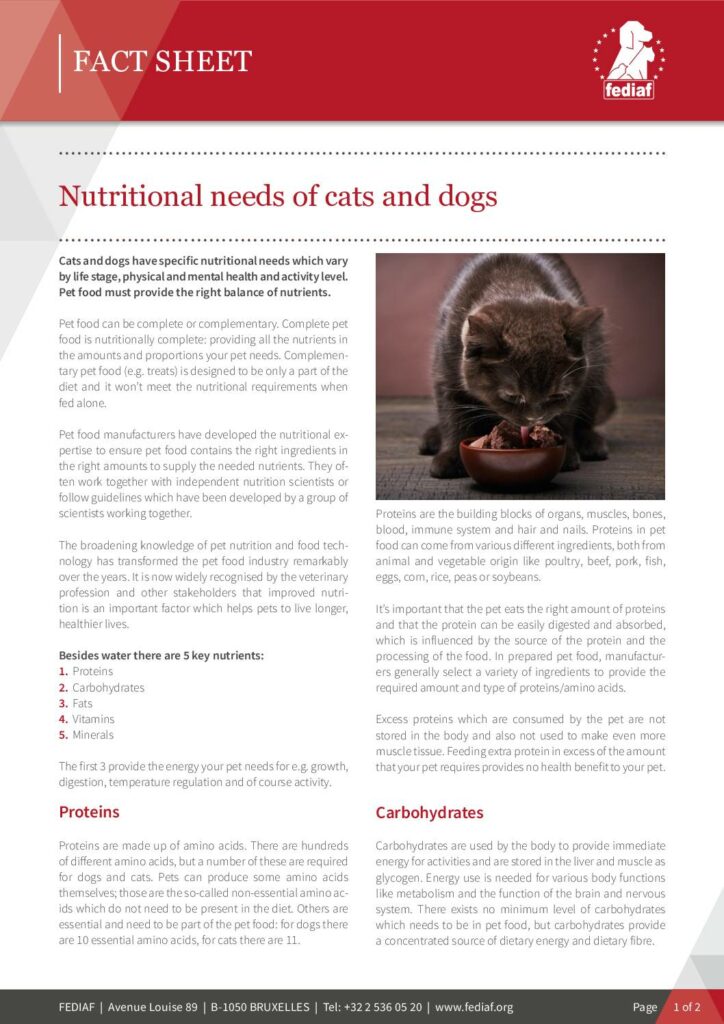Cats and dogs have specific nutritional needs which vary by life stage, physical and mental health and activity level. Pet food must provide the right balance of nutrients.
Pet food can be complete or complementary. Complete pet food is nutritionally complete: providing all the nutrients in the amounts and proportions your pet needs. Complementary pet food (e.g. treats) is designed to be only a part of the diet and it won’t meet the nutritional requirements when fed alone.
Pet food manufacturers have developed the nutritional expertise to ensure pet food contains the right ingredients in the right amounts to supply the needed nutrients. They often work together with independent nutrition scientists or follow guidelines which have been developed by a group of scientists working together.
The broadening knowledge of pet nutrition and food technology has transformed the pet food industry remarkably over the years. It is now widely recognised by the veterinary profession and other stakeholders that improved nutrition is an important factor which helps pets to live longer, healthier lives.
Besides water there are 5 key nutrients:
- Proteins
- Carbohydrates
- Fats
- Vitamins
- Minerals
The first 3 provide the energy your pet needs for e.g. growth, digestion, temperature regulation and of course activity.
Proteins
Proteins are made up of amino acids. There are hundreds of different amino acids, but a number of these are required for dogs and cats. Pets can produce some amino acids themselves; those are the so-called non-essential amino acids which do not need to be present in the diet. Others are essential and need to be part of the pet food: for dogs there are 10 essential amino acids, for cats there are 11.
Proteins are the building blocks of organs, muscles, bones, blood, immune system and hair and nails. Proteins in pet food can come from various different ingredients, both from animal and vegetable origin like poultry, beef, pork, fish, eggs, corn, rice, peas or soybeans.
It’s important that the pet eats the right amount of proteins and that the protein can be easily digested and absorbed, which is influenced by the source of the protein and the processing of the food. In prepared pet food, manufacturers generally select a variety of ingredients to provide the required amount and type of proteins/amino acids.
Excess proteins which are consumed by the pet are not stored in the body and also not used to make even more muscle tissue. Feeding extra protein in excess of the amount that your pet requires provides no health benefit to your pet.
Carbohydrates
Carbohydrates are used by the body to provide immediate energy for activities and are stored in the liver and muscle as glycogen. Energy use is needed for various body functions like metabolism and the function of the brain and nervous system. There exists no minimum level of carbohydrates which needs to be in pet food, but carbohydrates provide a concentrated source of dietary energy and dietary fibre.
There are two types: digestible carbohydrates (starches and sugars) which provide energy and indigestible carbohydrates (fibre) which are important for stool quality and gut motility. Fibres can help in weight management because they are low in calories and help provide the feeling of satiety.
The ingredients providing carbohydrates are mainly plant ingredients like corn, barley, peas, rice, wheat and potatoes. Dietary fibre sources include for instance dried beet pulp, wheat bran or soybean hulls. Many sources of carbohydrates also provide other nutrients like protein, fat or vitamins.
Because of the manufacturing process of grinding and cooking the carbohydrates become easily digestible. A genetic change in the ancestors of our modern dogs (compared with wolves) allowing them to thrive on a diet rich in starch was a crucial step in their early domestication. Also cats can utilise glucose from digesting starch in their diet. A key exception is the pet’s ability to digest lactose (milk sugar) because they have lower levels of the enzyme lactase required to split the lactose into individual sugars.
Dietary fat
Fats in pet food are a source of essential fatty acids which are needed to make certain hormones and maintain the cell membranes. Certain vitamins (A, D, E and K) can only be absorbed, stored and transported by fat. Dietary fats improve palatability and add texture for greater enjoyment of the food. And of course, fats are a great source of energy because they provide about 2 ½ times the level of energy that proteins or carbohydrates can provide. So especially for active animals fats are important, while at the same time we need to be careful with the fat intake for many indoor pets where controlling fat intake helps them not become overweight or obese.
Fats in pet food come from animal and vegetable sources.
Two key fatty acid families are the omega-3 and omega-6 (or n-3 and n-6) families. Omega-3 fatty acids are needed for cell membranes and reduces inflammation. Good sources of omega-3 fatty acids are fish, shellfish and flaxseed. Omega-6 fatty acids are important to aid in the process of repairing tissue and are found in vegetable oils.
Minerals & Vitamins
The major or macro minerals needed in the body are calcium, phosphorus, potassium, sodium, chloride and magnesium. The amounts needed of the trace elements are much smaller and these include for instance iron, copper and selenium.
Vitamins are nutrients needed in very small amounts, but they enable many functions in the body. Dogs and cats cannot make all the vitamins they need; so these must be supplied by the food.
Minerals and vitamins are partly provided by the ingredients which deliver the major nutrients of protein, carbohydrates and fat and the other minerals and vitamins are added to the recipe.
